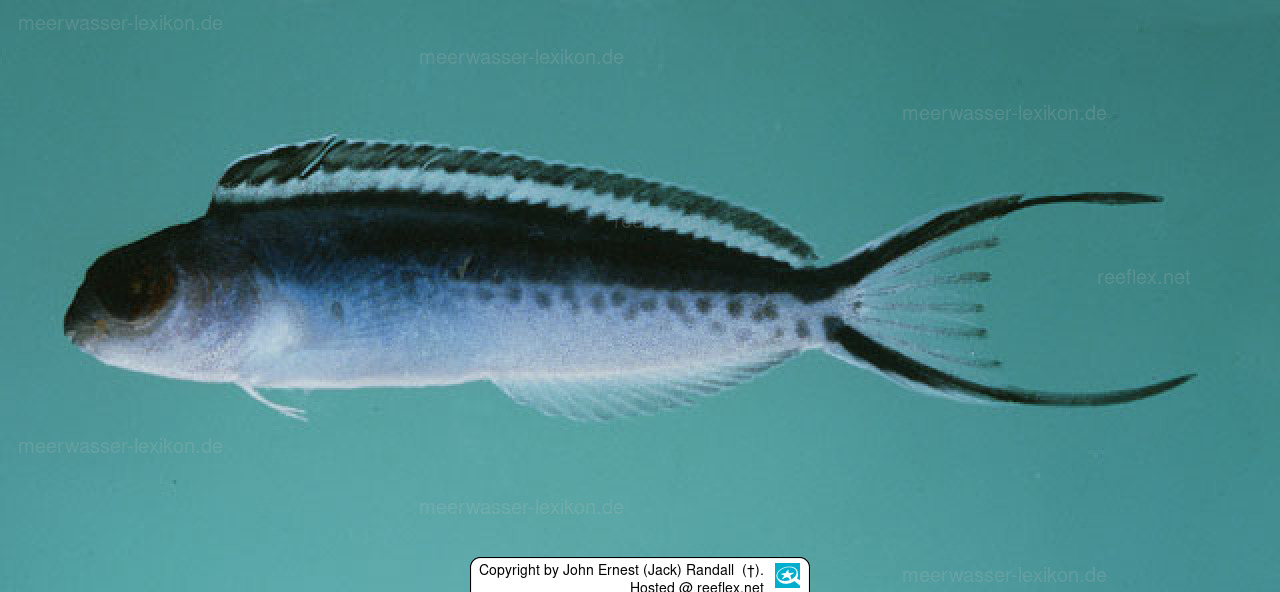Info
There are 5 genera of sabre-toothed blennies:
Aspidontus
Meiacanthus
Petroscirtes
Plagiotremus
Xiphasia
Meiacanthus procne is widespread and locally common in the waters around Toga.
Meiacanthus are characterized by their grooved canine teeth and the associated glands.
Sabretooth blennies are unique among fishes in that they have highly specialized venomous buccal glands.
The species have a well-developed swim bladder and are less susceptible to predation, which allows them to feed in the water column and forage over a large area.
Sabretooth blennies are not suitable for saltwater aquariums with the usual fish stocking and are not available in specialist shops.
Feeding intake.
The fish take a long time to eat at the beginning, before the food is taken up, a close inspection is carried out. After acclimatisation, the offered frozen food is eaten without problems. It should be noted that wild-caught fish behave differently than offspring when it comes to food intake. In the case of offspring, the size of the fish purchased also plays a role in the choice of food.
The saber-tooth blennies are already sexed after birth. Male adult fish have larger ventral or caudal fins or longer flippers. Males swim at females repeatedly and exhibit a color change during courtship. Females have a pronounced abdominal fullness. A subsequent mating attempt can result in significant fighting or death of the weaker fish. The best chance is to purchase a pair already from the dealer.
The Sabertooth blenny has strongly elongated canine teeth in the lower jaw which are provided with poison glands, as in all Meiacanthus species. The Sabertooth blenny uses its venom glands effectively in defense, the keeper should be aware that a bite from the Sabertooth blenny will cause a comparable pain,
Meiacanthus species have a swim bladder, this allows them to move permanently in open water.
Socialisation with other Meiacanthus species.
In large tanks, socialisation of several Meiacanthus species is possible.
Meiacanthus grammistes, Meiacanthus kamoharai, Meiacanthus nigrolineatus and Meiacanthus oualanensis
Aspidontus
Meiacanthus
Petroscirtes
Plagiotremus
Xiphasia
Meiacanthus procne is widespread and locally common in the waters around Toga.
Meiacanthus are characterized by their grooved canine teeth and the associated glands.
Sabretooth blennies are unique among fishes in that they have highly specialized venomous buccal glands.
The species have a well-developed swim bladder and are less susceptible to predation, which allows them to feed in the water column and forage over a large area.
Sabretooth blennies are not suitable for saltwater aquariums with the usual fish stocking and are not available in specialist shops.
Feeding intake.
The fish take a long time to eat at the beginning, before the food is taken up, a close inspection is carried out. After acclimatisation, the offered frozen food is eaten without problems. It should be noted that wild-caught fish behave differently than offspring when it comes to food intake. In the case of offspring, the size of the fish purchased also plays a role in the choice of food.
The saber-tooth blennies are already sexed after birth. Male adult fish have larger ventral or caudal fins or longer flippers. Males swim at females repeatedly and exhibit a color change during courtship. Females have a pronounced abdominal fullness. A subsequent mating attempt can result in significant fighting or death of the weaker fish. The best chance is to purchase a pair already from the dealer.
The Sabertooth blenny has strongly elongated canine teeth in the lower jaw which are provided with poison glands, as in all Meiacanthus species. The Sabertooth blenny uses its venom glands effectively in defense, the keeper should be aware that a bite from the Sabertooth blenny will cause a comparable pain,
Meiacanthus species have a swim bladder, this allows them to move permanently in open water.
Socialisation with other Meiacanthus species.
In large tanks, socialisation of several Meiacanthus species is possible.
Meiacanthus grammistes, Meiacanthus kamoharai, Meiacanthus nigrolineatus and Meiacanthus oualanensis







 Dr. John Ernest (Jack) Randall (†), Hawaii
Dr. John Ernest (Jack) Randall (†), Hawaii



























